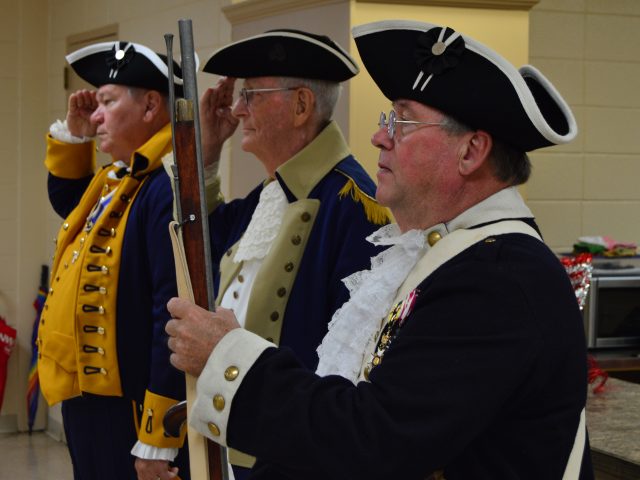
By John Balch
Leader staff
American history was recounted last week in Murfreesboro when the grave of Lieutenant Williams Jenkins (1762-1842) was dedicated during a ceremony presented by the Sons and Daughters of the American Revolution.
The event was moved indoors as a storm system approached the Murfreesboro Cemetery and rain pounded Jenkins gravestone a few blocks away. The dedication was more than a year in the making and was hosted by the Arkadelphia Chapter of the Daughters of the American Revolution and the Mine Creek-Paraclifta DAR chapter. Also on hand were representatives of the Sons of the American Revolution. Many of those in attendance were garbed in historical dress and the uniforms of the American Revolution soldiers.
The Arkadelphia High School JROTC Color Guard presented the flags and bugler Jim Lloyd, band director of Arkansas High School, played “Taps.” The National Anthem was performed by Cadet Staff Sergeant Mehkia Wilson of Arkadelphia High School.
Presenters included Charlotte Jeffers, regent of the Arkadelphia Chapter of the National Society of Daughters of the American Revolution and Susan Veal of the Caddo District of NSDAR. The greeting was offered by Charles McLemore, president of the DeStoto Trace Chapters of the Sons of the American Revolution.
The unveiling was conducted by Laverne Todd of the Arkadelphia DAR chapter and the invitation came from Judy Hile of Murfreesboro, a member of the Mine Creek-Paraclifta DAR chapter. The benediction was by Charlotte Gibson, vice regent of the Mine Creek-Paraclifta chapter and the dedication prayer was by Tommie Anderson, chaplain of the Arkadelphia chapter.
A special tribute to Jenkins was presented by Dr. Tony Kassos of Nashville. The following is the text of the presentation entitled: A Tribute to William Jenkins: Revolutionary War Soldier:
We are here today to pay tribute to William Jenkins, a Revolutionary War soldier who served in the South Carolina militia.
To understand the significance of Mr. Jenkins’ contribution, we must put it in historical context. By 1780 the War was stalemated. Neither side had the strength to gain a decisive victory over the other. In order to break the stalemate, the British decided to move the war south to the colony of South Carolina. This seemed a good idea as there was more sympathy for the British in the Southern colonies than in the North. In the South at the that time as many Americans fought for the Crown as for the Continental Government.
The first target of the British was the port of Charleston, the most important city in the South. A British army under General Cornwallis besieged and captured the port on May 12, 1780. The entire Continental Army of the South, consisting of 5,466 men, was captured and imprisoned. General Cornwallis then established a series of forts in the interior of South Carolina to control the countryside. His control over the south was assured when he decisively defeated a Continental Army relief force under General Horatio Gates at the Battle of Camden.
From that time until the end of the war, the American cause in South Carolina was carried by local militia which conducted a guerrilla war.
Sometime in May, immediately after the fall of Charleston, Mr, Jenkins, at the age of 18, joined the South Carolina militia. The militia was given little training, had no uniforms, and had to furnish his own weapons. It was composed of farmers who sometimes had to take leave to work their farms and tend to their families. Due to his youth, Mr. Jenkins could stay with the militia full-time, which could explain his rapid rise through the ranks to sergeant, to lieutenant and eventually to captain.
He served under General Thomas Sumter, a plantation owner who, when he heard about the fall of Charleston, left and joined the revolution. Sumter is the Revolutionary War hero most honored in the state of South Carolina. Fort Sumter, of Civil War fame, is named after him. General Sumter led the South Carolina militia on a guerrilla campaign against the British that isolated their interior forts by attacking their supply and communication lines. His campaign dissipated British resources and resolve. At the same time, the considerate way he treated civilians, as opposed to the brutal British reprisals, steadily won the hearts and minds of the populace. It also steadily weakened the morale and resolve of the Tory militia, who at an ever increasing rate, gave up fighting for the Crown and returned to their farms. The British became more and more isolated in their Charleston stronghold.
Mr. Jenkins’ war would mostly have been one of scouting, and small engagements with Tory militia. However, we know of one major action in which he participated. Jenkins was part of a unit led by Colonel William Bratton. Bratton’s farm was raided by a British unit under Captain Christian Huck, a British officer notorious for carrying out vicious reprisals against individuals suspected of assisting rebels. One of Huck’s soldiers held a sword at Bratton’s wife Martha’s throat and threatened her with death if she did not disclose the location of her husband. She refused, and was only saved by death by a British officer who interceded with the threatening soldier. She was forced to prepare dinner for the British. While doing so, she got a message to her husband. Colonel Bratton organized an attack with about 75 men including Jenkins. All the British soldiers were killed or captured. Among the dead was Christian Huck. The defeat of Huck encouraged many men in the area to join the armed struggle against the British and was a turning point for the war in South Carolina. Incidentally, the British officer who saved Mrs. Bratton survived and, because of his humane treatment of Mrs. Bratton, was allowed to be part of a prisoner exchange rather than being executed or retained as a prisoner of war.
In January 1781, George Washington finally sent a Continental Army to the South under General Nathaniel Green. Cornwallis came out from Charleston to meet him. Due to the work of the South Carolina militia, Cornwallis moved through a hostile population that refused him aid and reported his every move. Cornwallis was subsequently defeated at the Battle of Cowpens on Jan. 17, 1781, and again at the Battle of Gilford Courthouse on March 14, 1781. Because of these defeats, and because he could not obtain supplies from the South Carolina countryside, Cornwallis was forced to abandon Charleston and march to Yorktown, Virginia. The rest is history.
Mr. Jenkins left the South Carolina militia after the war and, like most of his countrymen, became a small subsistence farmer. He married and had three children. He lived in South Carolina until 1812, when, like many of his contemporaries, he moved West for new opportunities. He lived for awhile in Tennessee and then in Alabama. Along the way his first wife died and he remarried. Finally, in 1837, at the age of 75, he arrived in Murfreesboro, Arkansas with a son Jesse Jenkins, a Methodist minister. He died Oct. 14, 1842, at the age of 80. He was the second person buried in the Murfreesboro Cemetery, where he still resides. His second wife is also buried in this cemetery.







